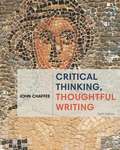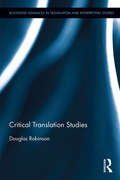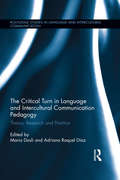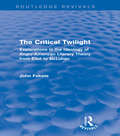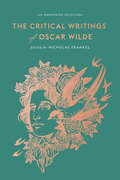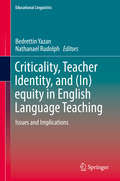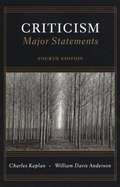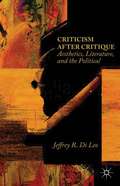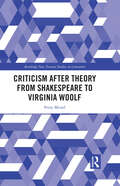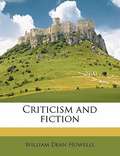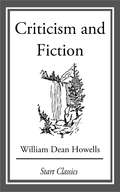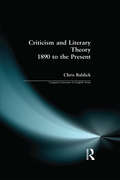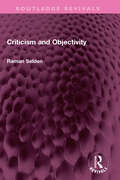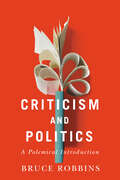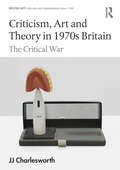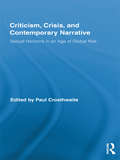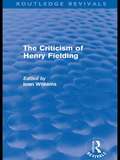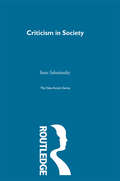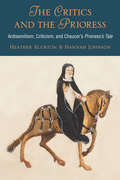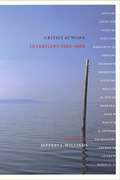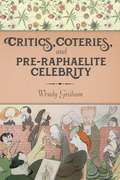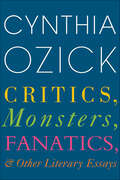- Table View
- List View
Critical Thinking, Thoughtful Writing, 6th Edition
by John ChaffeeEmphasizing that thinking well and writing well are invariably connected, CRITICAL THINKING, THOUGHTFUL WRITING, 6e delivers thorough coverage of the writing process, going beyond the traditional rhetoric to teach you how to evaluate sources, images, and arguments. This rhetoric with readings introduces the process of thinking critically as a powerful approach to writing, to critically evaluating electronic and visual media, and to life in general. Each chapter focuses on a critical-thinking skill--such as problem solving or analysis of complex issues--that is explored through Thinking-Writing Activities and thematically linked readings. Each of the readings challenges you to read actively, think critically, and then write about the readings. The Sixth Edition offers provocative new readings, a four-color interior design, expanded writing projects that help you fully interact with the writing process, annotations to student essays, and more in-chapter questions to help you reflect on the material.
Critical Translation Studies: Centrifugal Theories, Critical Interventions (Routledge Advances in Translation and Interpreting Studies #Vol. 4)
by Douglas RobinsonThis book offers an introduction for Translation Studies (TS) scholars to Critical Translation Studies (CTS), a cultural-studies approach to the study of translation spearheaded by Sakai Naoki and Lydia H. Liu, with an implicit focus on translation as a social practice shaped by power relations in society. The central claim in CTS is that translators help condition what TS scholars take to be the primal scene of translation: two languages, two language communities, with the translator as mediator. According to Sakai, intralingual translation is primal: we are all foreigners to each other, making every address to another "heterolingual", thus a form of translation; and it is the order that these acts of translation bring to communication that begins to generate the "two separate languages" scenario. CTS is dedicated to the historicization of the social relations that create that scenario. In three sets of "Critical Theses on Translation," the book outlines and explains (and partly critiques) the CTS approach; in five interspersed chapters, the book delves more deeply into CTS, with an eye to making it do work that will be useful to TS scholars.
The Critical Turn in Language and Intercultural Communication Pedagogy: Theory, Research and Practice (Routledge Studies in Language and Intercultural Communication)
by Maria Dasli Adriana Raquel DíazThis edited research volume explores the development of what can be described as the ‘critical turn’ in intercultural communication pedagogy, with a particular focus on modern/foreign language education. The main aim is to trace the realisations of this critical turn against a background of unequal power relations, and to illuminate the role that radical culture educators can play in the making of a more democratic and egalitarian social order. The volume takes as a starting point the idea that criticality draws on a number of intellectual traditions, which do not always focus on social and political critique, and argues that because ideological hegemony impacts on the meanings that people create and share, intercultural communication pedagogy ought to locate itself within wider socio-political contexts. With reference points drawn from critical and transnational social theory, critical pedagogy and intercultural theory, contributors to this volume provide readers with powerful ways that show how this can be achieved, and together assess the impact that their understanding of criticality can make on modern/foreign language education. The volume is divided into three major parts, namely: ‘theorising critically’, ‘researching critically’ and ‘teaching critically’.
The Critical Twilight: Explorations in the Ideology of Anglo-American Literary Theory from Eliot to McLuhan (Routledge Revivals)
by John FeketeFirst published in 1977, this book was the first to map extensively the ideological typography of the Anglo-American tradition of literary theory. It interrogates, comprehensively and in detail, the assumptions and categorical development within critical ideas from I. A. Richards and T. S. Eliot, through John Crowe Ransom and the New Criticism, to Northrop Frye and Marshall NcLuhan. This analysis reveals the Anglo-American tradition of literary-cultural theory is most properly intelligible within the overall field of social consciousness as an ideology of progressive cultural rationalization. Against a background of ideological development since nineteenth-century Romanticism, John Fekete illuminates the boundaries of literary ideology in relation to the shapes and changes of modern culture and society.
The Critical Writings of Oscar Wilde: An Annotated Selection
by Oscar WildeAn authoritative edition of Oscar Wilde’s critical writings shows how the renowned dramatist and novelist also transformed the art of commentary.Though he is primarily acclaimed today for his drama and fiction, Oscar Wilde was also one of the greatest critics of his generation. Annotated and introduced by Wilde scholar Nicholas Frankel, this unique collection reveals Wilde as a writer who transformed criticism, giving the genre new purpose, injecting it with style and wit, and reorienting it toward the kinds of social concerns that still occupy our most engaging cultural commentators.“Criticism is itself an art,” Wilde wrote, and The Critical Writings of Oscar Wilde demonstrates this philosophy in action. Readers will encounter some of Wilde’s most quotable writings, such as “The Decay of Lying,” which famously avers that “Life imitates Art far more than Art imitates life.” But Frankel also includes lesser-known works like “The American Invasion,” a witty celebration of modern femininity, and “Aristotle at Afternoon Tea,” in which Wilde deftly (and anonymously) carves up his former tutor’s own criticism. The essays, reviews, dialogues, and epigrams collected here cover an astonishing range of themes: literature, of course, but also fashion, politics, masculinity, cuisine, courtship, marriage—the breadth of Victorian England. If today’s critics address such topics as a matter of course, it is because Wilde showed that they could. It is hard to imagine a twenty-first-century criticism without him.
Criticality, Teacher Identity, and: Issues And Implications (Educational Linguistics #35)
by Nathanael Rudolph Bedrettin YazanThis edited volume, envisioned through a postmodern and poststructural lens, represents an effort to destabilize the normalized “assumption” in the discursive field of English language teaching (ELT) (Pennycook, 2007), critically-oriented and otherwise, that identity, experience, privilege-marginalization, (in)equity, and interaction, can and should be apprehended and attended to via categories embedded within binaries (e.g., NS/NNS; NEST/NNEST). The volume provides space for authors and readers alike to explore fluidly critical-practical approaches to identity, experience, (in)equity, and interaction envisioned through and beyond binaries, and to examine the implications such approaches hold for attending to the contextual complexity of identity and interaction, in and beyond the classroom. The volume additionally serves to prompt criticality in ELT towards reflexivity, conceptual clarity and congruence, and dialogue.
Criticism: Major Statements (4th edition)
by Charles Kaplan William Davis AndersonThis anthology encompasses the historic sweep of literary criticism from Plato to the present in a compact format.
Criticism after Critique: Aesthetics, Literature, and the Political
by Jeffrey R. Di LeoPresenting different ways to imagine criticism without critique, this collection provides a survey of both the difficult times facing ideological critique and the ways in which literary criticism and aesthetics have been affected by changing attitudes toward critique.
Criticism After Theory from Shakespeare to Virginia Woolf (Routledge New Textual Studies in Literature #1)
by Perry MeiselThe argument of this book is a simple one: that criticism after theory is a single movement of thought defined by synthesis and continuity rather than by conflict and change. The most influential figures in criticism since Saussure—Bakhtin, Derrida, and Foucault—are wholly consistent with Saussure's foundational Course in General Linguistics (1916) no matter the traditions of complaint that have followed in Saussure's wake from Bakhtin forward. These complaints vitiate—despite themselves and often hilariously so—the misconceptions that have made cottage industries out of quarrels with Saussurean semiology that are based on notions of Saussure that are incorrect. The materialist criticism dominant today is actually dependent upon on the legacy of a presumably formalist structuralism rather than a step beyond it. New Historicism, postcolonialism, gender studies, environmental criticism, archive studies, even shared and surface reading are, like deconstruction, the by-products of Saussure's structuralism, not its foils. Saussure's sign is sensory and concrete. Language and materiality are not distinct but one and the same—history, society, the psychological subject, even the environment are systems of signs, material archives read and reread by futures that produce the past after the fact. Without Saussure, contemporary criticism would have no identifiable or effective source. The book begins with chapters on Saussure and Derrida, Bakhtin and Shakespeare, and Freud and Foucault followed by chapters on Victorian and American fiction, D.H. Lawrence and modern poetry, Virginia Woolf and Melanie Klein, and the historicist tropology of psychoanalysis. It concludes with a coda in life writing on the author's epileptic disability.
Criticism and Fiction
by William Dean HowellsWilliam Dean Howells (1837-1920) was an American realist author and literary critic. He wrote his first novel, Their Wedding Journey, in 1871, but his literary reputation really took off with the realist novel A Modern Instance, published in 1882, which describes the decay of a marriage. His 1885 novel The Rise of Silas Lapham is perhaps his best known, describing the rise and fall of an American entrepreneur in the paint business. His social views were also strongly reflected in the novels Annie Kilburn (1888) and A Hazard of New Fortunes (1890). While known primarily as a novelist, his short story "Editha" (1905) - included in the collection Between the Dark and the Daylight (1907) - appears in many anthologies of American literature. Howells also wrote plays, criticism, and essays about contemporary literary figures such as Ibsen, Zola, Verga, and, especially, Tolstoy, which helped establish their reputations in the United States. He also wrote critically in support of many American writers. It is perhaps in this role that he had his greatest influence.
Criticism and Literary Theory 1890 to the Present (Longman Literature In English Series)
by Chris BaldickPresents a coherent and accessible historical account of the major phases of British and American Twentieth-century criticism, from 'decadent' aestheticism to feminist, decontsructonist and post-colonial theories. Special attention is given to new perspectives on Shakesperean criticism, theories of the novel and models of the literary canon. The book will help to define and account for the major developments in literary criticism during this century exploring the full diversity of critical work from major critics such as T S Eliot and F R Leavis to minor but fascinating figures and critical schools. Unlike most guides to modern literary theory, its focus is firmly on developments within the English speaking world.
Criticism and Objectivity (Routledge Revivals)
by Raman SeldenFirst published in 1984 Criticism and Objectivity argues that literary critics should not abandon the concept of knowledge. English literary criticism has long considered ‘theory’ to be alien to the felt experience of readers and writers; the Romantic attitude towards reason and feeling has continued to inhibit the conceptual development of criticism. The similarities between the role of theory in science and in literary criticism imply the need for ‘objectivity’ to be redefined rather than abandoned. While accepting that tests are relatively open structures defying final interpretations, Dr Selden argues that their plurality is as much the effect of historical conditions as of the nature of language or subjectivity. He calls for an historical criticism capable of ‘conducting’ the voices of the text without resorting to formalism or reducing the text to its ‘background’. This book will be of interest to students of literary theory.
Criticism and Politics: A Polemical Introduction
by Bruce RobbinsAn accessible introduction to cultural theory and an original polemic about the purpose of criticism. What is criticism for? Over the past few decades, impassioned disagreements over that question in the academy have burst into the news media. These conflicts have renewed the culture wars over the legacy of the 1960s, becoming entangled in national politics and leading to a new set of questions about critics and the power they do or don't wield. Re-examining theorists from Matthew Arnold to Walter Benjamin, to Fredric Jameson, Stuart Hall, and Hortense Spillers, Criticism and Politics explores the animating contradictions that have long propelled literary studies: between pronouncing judgment and engaging in philosophical critique, between democracy and expertise, between political commitment and aesthetic autonomy. Both a leftist critic and a critic of the left, Robbins unflinchingly defends criticism from those who might wish to de-politicize it, arguing that working for change is not optional for critics, but rather a core part of their job description.
Criticism and the Growth of Knowledge
by Imre Lakatos Alan MusgraveTwo books have been particularly influential in contemporary philosophy of science: Karl R. Popper's Logic of Scientific Discovery, and Thomas S. Kuhn's Structure of Scientific Revolutions. Both agree upon the importance of revolutions in science, but differ about the role of criticism in science's revolutionary growth. This volume arose out of a symposium on Kuhn's work, with Popper in the chair, at an international colloquium held in London in 1965. The book begins with Kuhn's statement of his position followed by seven essays offering criticism and analysis, and finally by Kuhn's reply. The book will interest senior undergraduates and graduate students of the philosophy and history of science, as well as professional philosophers, philosophically inclined scientists, and some psychologists and sociologists.
Criticism and Truth: On Method in Literary Studies (Thinking Literature)
by Jonathan KramnickA defense and celebration of the discipline of literary studies and its most distinctive practice—close reading. Does literary criticism offer truths about the world? In Criticism and Truth, Jonathan Kramnick offers a new and surprising account of criticism’s power by zeroing in on its singular method: close reading. Long recognized as the distinctive technique of literary studies, close reading is the critic’s way of pursuing arguments and advancing knowledge, as well as the primary skill taught in the English major. But it is also more than that—a creative, immersive, and transformative writing practice that fosters a unique kind of engagement with the world. Drawing on the rich and varied landscape of contemporary criticism, Kramnick changes how we think about the basic tools of literary analysis, including the art of in-text quotation, summary, and other reading methods, helping us to see them as an invaluable form of humanistic expertise. Criticism and Truth is a call to arms, making a powerful case for the necessity of both literature and criticism within a multidisciplinary university. As the humanities fight for survival in contemporary higher education, the study of literature doesn’t need more plans for reform. Rather, it needs a defense of the work already being done and an account of why it should flourish. This is what Criticism and Truth offers, in vivid and portable form.
Criticism, Art and Theory in 1970s Britain: The Critical War (ISSN)
by JJ CharlesworthA critical study of the life of art criticism in the 1970s, this volume traces the evolution of art and art criticism in a pivotal period in post-war British history.JJ Charlesworth explores how art critics and the art press attempted to negotiate new developments in art, faced with the challenges of conceptualism, alternative media, new social movements and radical innovations in philosophy and theory. This is the first comprehensive study of the art press and art criticism in Britain during this pivotal period, seen through the lens of its art press, charting the arguments and ideas that would come to shape contemporary art as we know it today.This book will be of interest to scholars working in art history, British cultural history and history of journalism.
Criticism, Crisis, and Contemporary Narrative: Textual Horizons in an Age of Global Risk (Routledge Studies in Contemporary Literature)
by Paul CrosthwaiteThe etymological affinity between ‘criticism’ and ‘crisis’ has never been more resonant than it is today, when social life is increasingly understood as defined by a succession of overlapping global crises: financial and economic crises; environmental crises; geopolitical crises; terrorist crises; public health crises. But what is the role of literary and cultural criticism in conceptualizing this atmosphere of perpetual crisis? If, as Paul de Man maintained, criticism necessarily exists in a state of crisis, in what ways is this condition intensified at a time when the social formations within which criticism operates and the cultural artefacts that it takes as its objects are themselves pervaded by actual and imagined states of emergency? This book, the first sustained response to these questions, demonstrates the capacity of critical thought, working in dialogue with key narrative texts, to provide penetrating insights into a contemporary landscape of global, manufactured risk. Written by an international team of specialist scholars, the essays in the collection draw on a wide variety of contemporary theoretical, fictional, and cinematic sources, ranging from Giorgio Agamben, Jacques Derrida, and Fredric Jameson to Cormac McCarthy, Ian McEwan, and Lauren Beukes to Ghost and the James Bond and National Treasure series. Appearing in the midst of a phase of extraordinary turbulence in the fabric of our interconnected and interdependent world, the book makes a landmark intervention in debates concerning the cultural ramifications of globalization.
The Criticism of Henry Fielding (Routledge Revivals)
by Ioan WilliamsFirst published in 1970, this selection of Fielding’s criticism is an important contribution to our understanding of Fielding and his age. It directs considerable light upon Fielding’s own critical views, with regard both to his own works and to eighteenth-century life and literature at large. The volume includes many of Fielding’s well-known and important statements on literature, society and morals, as well as many which are now difficult to obtain. The selection presents the full range of Fielding’s criticism, showing the relations between his statements concerning literature and his opinions on other matters, and drawing on the complete body of his work. The editor has provided a large-scale analytical introduction.
Criticism & Society
by Imre SalusinszkyFirst Published in 2002. Routledge is an imprint of Taylor & Francis, an informa company.
The Critics and the Prioress: Antisemitism, Criticism, and Chaucer's Prioress's Tale
by Hannah Johnson Heather BlurtonOf all the Canterbury Tales, Geoffrey Chaucer’s Prioress’s Tale, in which a young schoolboy is murdered by Jews for singing a song in praise of the Virgin Mary, poses a problem to contemporary readers because of the anti-semitism of the story it tells. Both the Tale’s anti-semitism and its “Chaucerianism”— its fitness or aptness as part of the Chaucerian canon—are significant topics of reflection for modern readers, who worry about the Tale’s ethical implications as well as Chaucer’s own implications. Over the past fifty years, scholars have asked whether the anti-semitism in the tale is that of the Prioress? Or of Chaucer the pilgrim? Or of Chaucer the author? Or, indeed, whether one ought to discuss anti-semitism in the Prioress’s Tale at all, considering the potential anachronism of expecting medieval texts to conform to contemporary ideologies. The Critics and the Prioress responds to a critical stalemate between the demands of ethics and the entailments of methodology. The book addresses key moments in criticism of the Prioress’s Tale—particularly those which stage an encounter between historicism and ethics—in order to interrogate these critical impasses while suggesting new modes for future encounters. It is an effort to identify, engage, and reframe some significant—and perennially repeated—arguments staked out in this criticism, such as the roles of gender, aesthetics, source studies, and the appropriate relationship between ethics and historicism. The Critics and the Prioress will be an essential resource for Chaucer scholars researching as well as teaching the Prioress’s Tale. Scholars and students of Middle English literature and medieval culture more generally will also be interested in this book’s rigorous analysis of contemporary scholarly approaches to expressions of anti-semitism in Chaucer’s England.
Critics at Work: Interviews 1993-2003 (Cultural Front)
by Jeffrey J. WilliamsFeaturing interviews with nineteen leading U.S. literary and cultural critics, Critics at Work offers a unique picture of recent developments in literary studies, critical theory, American studies, gay and lesbian studies, philosophy, and other fields. It provides informative, timely, and often provocative commentary on a broad range of topics, from the state of theory today and the prospects for cultural studies to the role of public intellectuals and the place of political activism. These conversations also elicit illuminating and sometimes surprising insights into the personal and professional lives of its contributors. Individually, each interview gives a significant overview of a critic's work. Taken together, they provide an assessment of literary and cultural studies from the establishment of theory and its diffusion, in recent years, into various cultural and identity studies. In addition to the interviews themselves, the volume includes useful short introductions to each critic's work and biography. Interviewees: K. Anthony Appiah, Lauren Berlant, Cathy Davidson, Morris Dickstein, Stanley Fish, Barbara Foley, Nancy Fraser, Gerald Graff, Alice Kaplan, E. Ann Kaplan, Robin D.G. Kelley, Paul Lauter, Louis Menand, Richard Ohmann, Andrew Ross, Eve Kosofsky Sedgwick, Jane Tompkins, Marianna Torgovnick, and Alan Wald.
Critics, Coteries, and Pre-Raphaelite Celebrity (Gender and Culture Series)
by Wendy GrahamFounded by a band of young iconoclasts, the Pre-Raphaelite Brotherhood stunned Victorian England with its revaluation of culture and lifestyle. With Pre-Raphaelitism ascendant in the 1850s and canonical by the 1880s, the movement’s refractory reception history is an object lesson in how avant-gardes burst upon the scene, dispense with their antagonistic posture, and become a mainstay of tradition. Wendy Graham traces the critical discourses that greeted the Pre-Raphaelites’ debut, shaped their contemporary reception, and continued to inform responses to them well after their heyday. She explains the mechanics of fame and the politics of scandal contributing to the rise of aestheticism, providing a new interpretation of the place of aesthetic counterculture in Victorian England.Critics, Coteries, and Pre-Raphaelite Celebrity sheds new light on Victorian discourses on sexuality and masculinity through a thick description of literary bravado, the emotions of male bonding within cliques, and homoerotic frissons among the creators and reviewers of Pre-Raphaelitism. Graham threads together the qualities that made William Holman Hunt, John Everett Millais, and Gabriel Rossetti exemplary figures of aesthetic celebrity in the 1850s; Algernon Swinburne and Simeon Solomon in the 1860s; and Edward Burne-Jones and Walter Pater in the 1870s. The book documents the symbiotic relationship between periodical writers and the artists and poets they helped make famous, demonstrating that the origin myth of Bohemian artistic transcendence was connected with the rise of a professional class of journalists. Graham shows that the Pre-Raphaelites innovated many of the phenomena now associated with Oscar Wilde, arguing that they were foundational for him in forging an artistic and personal identity with a full-blown publicity apparatus. Wilde had models. This book is about them.
Critics, Monsters, Fanatics, & Other Literary Essays
by Cynthia OzickIn a collection that includes new essays written explicitly for this volume, one of our sharpest and most influential critics confronts the past, present, and future of literary culture. If every outlet for book criticism suddenly disappeared — if all we had were reviews that treated books like any other commodity — could the novel survive? In a gauntlet-throwing essay at the start of this brilliant assemblage, Cynthia Ozick stakes the claim that, just as surely as critics require a steady supply of new fiction, novelists need great critics to build a vibrant community on the foundation of literary history. For decades, Ozick herself has been one of our great critics, as these essays so clearly display. She offers models of critical analysis of writers from the mid-twentieth century to today, from Saul Bellow, Bernard Malamud, and Kafka, to William Gass and Martin Amis, all assembled in provocatively named groups: Fanatics, Monsters, Figures, and others. Uncompromising and brimming with insight, these essays are essential reading for anyone facing the future of literature in the digital age.
Critics of Enlightenment Rationalism Revisited (Palgrave Studies in Classical Liberalism)
by Gene Callahan Kenneth B. McIntyreThis book provides an overview of some of the most important critics of “Enlightenment rationalism.” The subjects of the volume (including, among others, Pascal, Vico, Schmitt, Weber, Anscombe, Scruton, and Tolkien) do not share a philosophical tradition as much as a skeptical disposition toward the notion, common among modern thinkers, that there is only one standard of rationality or reasonableness, and that that one standard is or ought to be taken from the presuppositions, methods, and logic of the natural sciences. The essays on each thinker are intended not merely to offer a commentary on that thinker, but also to place the person in the context of this larger stream of anti-rationalist thought.
